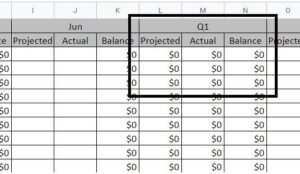How To Create An Annual B2B Marketing Budget [With Template]
![How To Create An Annual B2B Marketing Budget [With Template]](https://skalegrow.com/wp-content/uploads/2024/12/B2B-Marketing-Budget-1024x576.png)
This article was originally published in the Elevate Your Marketing newsletter and has been repurposed and republished here with the author’s permission. Here is the link to the original article.
We are approaching the end of the financial year soon. CROs, CMOs, and founders are trying to get their act together to welcome 2024-25 with a bang. And given that marketing is one of the most critical growth levers for B2B businesses, this is the time when marketing leaders are starting to plan next year’s activities and budget.
In this blog post, I guide you through the entire process of preparing an annual marketing budget for your business. To make the steps I cover more actionable, I have also added a budget template that you can right away start using – irrespective of the type of business or industry you are in.
That said, let’s roll.
Components of an annual B2B marketing budget
The very first step to creating a marketing budget is understanding the components involved in it. Broadly speaking, the total marketing spending of a company can be categorized into two:
- General marketing expenses
- Tools and subscriptions
Now, if your marketing team is large (or if every business unit has a separate marketing team), you might want to track your expenses by team or division. There could be expenses that are specific to a business unit – say a third-party media campaign.
But essentially, at a 10000 feet level, you would only have the two types of expenses I mentioned above.
Now, let us learn what constitutes the two categories.
B2B marketing budget allocation – General marketing expenses
This category includes everything but the money you spend on martech and other subscriptions and fees. This would include:

Elements of B2B marketing budget
- Branding, design, & PR: This combines everything you spend on improving brand awareness, maintaining public relations, and creative design.
- Advertising and media buying: This includes your entire advertising spend across platforms like Google ads, Facebook, LinkedIn, etc.
- Content marketing: Content is broad. But here, we are referring to any content-related services you outsource. Examples are translation services and content writing services.
- Website & SEO: As the term suggests, this subcategory includes all website and SEO-related costs such as website maintenance & support, paid backlink placements, agency fees, etc.
- Corporate: This usually includes any team-level or central expenses and items that cannot be included in any of the other subcategories. A good example would be any training programs you conduct for the whole marketing team.
- Sales enablement; This in general means anything that is required from the marketing side to support sales. This could overlap with some of the other subcategories listed. Technically, any effort that equips the sales team with the right set of tools and insights can be brought under this. A great example is customer interviews.
- Market research and analyst relations: All activities related to outsourced market research and maintaining analyst relations would fall into this subcategory.
- Event marketing: Event marketing costs include booth setup, travel & accommodation costs, printing branded items, etc.
- Travel expenses (other than events): This covers travel expenses incurred for marketing team members in addition to event-related travel.
- Partnership marketing: This includes partnership fees and other comarketing activities done in collaboration with partner organizations.
- Agencies and third-party vendors: You could add agency fees either under a related subcategory, or consolidate all those under this section.
Tools and subscriptions
Tools and subscriptions include subscription costs of all the tools in your marketing tech stack and any subscription fee you pay for a fixed period for other marketing services. Depending on what your martech stack and other subscription-based marketing initiatives look like, the expense items in this category can vary.
For this reason, the number of subcategories cannot be fixed. However, here I have listed all the common types of subscriptions with the addition of one item that is not so common – intent intelligence & personalization:
- Branding: This would include PR site subscriptions, employee social sharing app cost, employer branding-related subscriptions, etc.
- Design: This subcategory would comprise all the tools used for graphic design, video/audio editing, and 3D animation.
- Social media: Some of the types of tools used for social media include scheduling tools, social listening & analytics tools, paid platform subscriptions (like LinkedIn Sales Navigator), automation tools (like Dripify), etc.
- Email and marketing automation: Any tool used for automating email marketing and other marketing activities would fall into this subcategory.
- Content marketing: Content marketing involves using tools for grammar & spell check, sentence correction, checking plagiarism, generating new content, and more.
- Website & SEO: From keyword tools to website monitoring tools and heatmap analyzers, there is a wide variety of tools and tech needed to run your business’ website and SEO activities.
- Corporate: As in the case of general expenses, this subcategory will have all the tools used commonly across different functions or teams within marketing. Examples include webinar hosting platforms, subscriptions to online training platforms (like Udemy), a video conferencing application like Zoom, etc.
- Market research & sales intelligence: This includes database & sales intelligence platforms like ZoomInfo, Draup, Slintel, Gong, etc.
- Intent intelligence & personalization: Examples of a few intent intelligence platforms are Demandbase, Terminus, and 6sense. Some of these platforms offer web personalization as well. However, there are specialized personalization tools such as Evergage, Adobe Target, Sitespect, etc.
- Marketing analytics: This would include any tool you use to collect, monitor, analyze, and visualize data. A few examples are Google Data Studio, PowerBI, and Matomo.
That summarizes the subcategories under the two main categories of marketing expenses. As mentioned before, there could be slight variations in the subcategories – within each category – depending on the nature and stage of your business.
For instance, you might not have travel expenses at all if you are not having any of your employees travel for business purposes. Or maybe event marketing is not part of your marketing mix. The objective of this categorization is to give a structure to creating the annual marketing budget. You need to make sure to adapt it based on the domain your company is in.
Understanding the annual B2B marketing budget template
Now, let us get to the actionable part of this blog post – which is learning to use the marketing budget template. Given below is the link to the same:
[Note: All the cells of the template where values need to be entered have been kept empty. If you see the value as $0 in a cell, it means that it is a derived number. The values will automatically change as you enter the budget and expense details in the projected and actual columns].
As you can see in the Excel sheet, I have divided the template into four tabs:
- Overview: This is a summary of what each tab is about.
- General expenses: This is where you enter all the dollar values of the items that belong to the general marketing expenses category.
- Tools & subscriptions: This is where you enter all the tools and subscriptions related costs.
- Totals: This tab gives you the total values for all the budget items and budget utilization.
Next, let us look at some of the other particulars of the budget template.
You can see that for every month (in the general expenses and tools and subscriptions tabs), there are three columns – projected, annual, and balance (please see the image below to understand what I am referring to).

Marketing budget template – projected and actual
Here, projected means the budget you have allocated to that subcategory, whereas actual is the money you end up spending for it. Hence, you will be entering the allocated budget value in the projected column at the beginning of every financial year during the budget planning phase. The actual value can be entered at the end of every month once you have concluded the spending for the subcategory for that month.
‘Balance’ is a derived value. It is nothing but the difference between the projected and actual expenses. So depending on the values you enter in the projected and actual columns, the balance value will be auto-calculated.
To make the quarterly analysis of your budget spending easy, I have also given separate columns for each quarter of the year as seen in the image below:

Marketing budget template – quarterly analysis
In addition, following are the other totals given in the general expenses and tools & subscriptions tabs:
- Monthwise totals of projected, actual, and balance (row #51 in the general expenses tab and row #39 in the tools and subscriptions tab).
- Quarterly totals of projected, actual, and balance.
- Yearly total (for projected, actual, and balance) for each subcategory (columns AY, AZ, and BA in both tabs).
The totals tab
As mentioned before, the totals tab gives you the total projected, actual, and balance values for the two categories – general expenses and tools & subscriptions. Rows 9 to 11 of the totals tab have the total budget values for both categories combined, as you can see in the below image:

Marketing budget template – totals
B2B marketing budget allocation – how to calculate budget utilization
In the totals tab of the budget template, you would have seen an item called ‘Budget utilization of the year’. Budget utilization is a measure of the extent to which an allocated marketing budget has been utilized.
It is calculated by taking the ratio of the total actual spending and the total projected/allocated budget. The value is usually represented in percentage.
Let us understand this through an example.
If the total allocated or projected budget for a year is $300K and you ended up spending $270K by the end of it, then budget utilization can be calculated as:
(270000/300000) x 100 = 90%.
There can be cases where you overspend the total budget or the budget for specific categories/subcategories. When your total spending exceeds the allocated budget, your utilization will be more than 100%.
On the other hand, if the spending in an individual category or subcategory exceeds the allocated budget for that category, the overall budget utilization could still be well under 100% if the other items compensate for the excess burn.
Now, why is calculating budget utilization important?
It can be a game-changer for a business as it serves the following purposes:
- It helps to identify leakage in your marketing spending. If one or more items are burning more money than they should be, budget utilization as a single metric is a good way to identify it.
- It helps to reduce budget wastage. Remember, every dollar given to the marketing team is a dollar lost for another function. Though businesses can always expand their total budget, in many cases, budget allocation happens as a distribution of the total available budget among multiple teams. Hence, if you don’t use the money allocated to you, some other team is probably losing out.
- Not using the allocated budget might lead to a reduced budget in the next financial year. CEOs and revenue leaders look at budget utilization as a metric to see if a particular function really needs the allocated budget. So if you don’t use the money given to you in a year, questions might be raised as to whether marketing really needs that much budget.
- It helps marketing leaders to redistribute the budget among different categories and subcategories for the next year – based on the spending in the current financial year – during the budget planning stage.
That’s all I wanted to cover in this article. You can start using the budget template right away to create the annual B2B marketing budget for your business. Make sure to adapt the template as needed.
Skalegrow – B2B marketing agency
Skalegrow is a B2B marketing agency aimed at making life better for marketing leaders and founders in the B2B space. It was founded to address two key challenges in the B2B world:
- The lack of quality of services offered by marketing agencies
- The misalignment of marketing activities with organizational level goals
By introducing a consultative approach to offering marketing services, Skalegrow strives to make growth simpler and predictable for B2B companies. From SEO-led content and video marketing to LinkedIn organic marketing and email marketing, we offer a complete suite of marketing services to the IT, SaaS, tech, and embedded systems industries. If you are looking for help in implementing marketing tactics that work, please write to us at info@skalegrow.com.
About the author

Naseef KPO is the Founder and CEO of Skalegrow. He comes with rich experience across multiple areas of B2B marketing including content marketing, demand generation, SEO, account-based marketing, marketing analytics, revenue attribution, marketing technology, etc. He writes thought-provoking and relevant articles on The Skalegrow Blog and his weekly LinkedIn newsletter Elevate Your Marketing.
Prior to starting Skalegrow, Naseef led large marketing teams in multi-million dollar B2B organizations where he made significant contributions to the topline growth of the business. He has also appeared on numerous podcasts where he shared his thoughts on trending marketing topics such as the application of AI in marketing, startup marketing, ABM, and B2B content marketing, just to name a few. Being the founder of Skalegrow, he is currently focusing on helping its clients stay ahead of their competition by using innovative yet practical marketing tactics.
You can connect with Naseef KPO on LinkedIn.

John Doe
Habitant morbi tristique senectus et netus et malesuada fames ac turpis egestas. Nullam vehicula eros in suscipit fringilla. Aenean quis ex hendrerit, fringilla diam egestas, hendrerit nunc. Nunc at egestas magna. Nullam eu tempus ipsum. Pellentesque arcu mi, condimentum sit amet tincidunt eget, tristique sed turpis. Cras tempor mollis ultrices.






![How To Craft A Cold Email Sequence That Works [With Examples]](https://skalegrow.com/wp-content/uploads/2024/12/How-To-Craft-A-Cold-Email-Sequence-1024x576.png)


 your marketing
your marketing  new-age tactics?
new-age tactics?